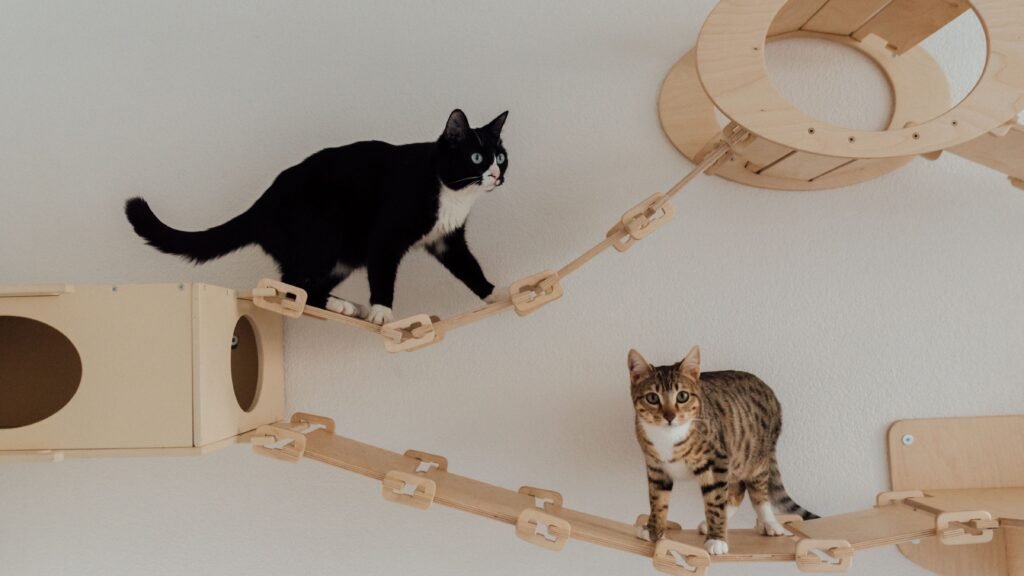
How to Build a Cat Sanctuary in Your Apartment
Published: September 7th, 2025
Turning Small Spaces Into Cat Havens
Living in an apartment doesn’t mean your cat has to miss out on adventure. Indoor cats, especially in urban environments, thrive when they have plenty of enrichment. With the right setup, even a studio can become a cat sanctuary. From climbing shelves to sensory play, here’s how to create a stimulating, cozy space that promotes feline health and happiness.
1. Vertical Territory: The Secret to Expanding Cat Space
Cats are natural climbers and observers. In small homes, the best way to expand their world is to think vertically.
-
Install cat shelves or floating ledges along your walls.
-
Add a cat tree (we love Mau for both quality and aesthetics).
-
Create a window perch so your cat can watch “cat TV” — birds, squirrels, and city life.
-
Consider a wall-mounted bridge or hammock for extra lounging spots.
2. Indoor “Catios” and Safe Nature Zones
Cats need to connect with nature. You can recreate outdoor experiences inside:
-
Cat grass planters for safe chewing.
-
A mini catio attached to a secure window or balcony.
-
Hideaway nooks with boxes, tunnels, or igloos.
-
Natural textures — sisal mats, cardboard scratchers, or driftwood-style climbing posts.
This gives your cats variety and simulates the outdoors without any of the risks.
3. Sensory Enrichment: Keep Their Minds Active
Cats need mental stimulation as much as physical activity.
-
Puzzle feeders or treat-dispensing toys to mimic hunting.
-
Scent games — hide catnip or silvervine in different corners for them to find.
-
Visual stimulation — bird feeders outside windows, or even cat-specific TV on YouTube.
-
Auditory enrichment — some cats respond positively to calming music or “cat music” playlists designed for feline relaxation.
4. Zen Spaces: The Power of Good Rest for Felines
Every cat sanctuary needs quiet spaces where cats can retreat.
-
Cozy beds tucked into corners.
-
A crate lined with blankets for low-light naps.
-
High perches where they can observe but remain undisturbed.
-
Rotating beds and blankets to refresh their environment and scent.
Cats need balance: the sanctuary should be as much about rest as it is about play.
5. Play Zones: Designated Fun Spaces
Having a dedicated area for play helps channel energy:
-
Tunnel systems where cats can chase and ambush each other.
-
Interactive toys like feather wands or laser pointers (always end with a toy catch to avoid frustration).
-
Rotating playtime schedules to prevent boredom.
Creating a play zone signals to your cats when it’s time for fun — and keeps them from turning your furniture into their playground.
6. Human-Friendly Design: Cat Spaces That Blend With Decor
You don’t need your home to look like a jungle gym to create a sanctuary. Stylish cat furniture is out there:
-
Minimalist cat shelves that double as décor.
-
Neutral-toned scratchers that blend into living rooms.
-
Mau cat trees and other designer brands that look like furniture, not pet gear.
A sanctuary should feel comfortable for you as well as your cats.
7. Health & Wellness: Keeping Cats Safe and Stimulated
When designing a sanctuary, think about long-term health:
-
Air circulation and sunlight — great for both cats and humans.
-
Safe plants — like cat grass, catnip, and cat-safe herbs.
-
No hazards — avoid toxic plants, dangling cords, or sharp-edged shelves.
-
Routine-friendly — feeding stations and litter boxes placed in consistent, accessible spots.
Final Thoughts: Every Apartment Can Be a Sanctuary
Cats don’t need endless square footage; they need thoughtful design. By creating vertical space, adding natural touches, rotating toys, and giving them restful retreats, you can build a cat sanctuary right in your apartment.
And if you ever need someone to keep your cats happy in their sanctuary while you’re away, try Feline Tails Cat Sitting. We make sure your cats get the same love, enrichment, and routine they’re used to — so you can travel worry-free.
📌 Quick Checklist: Your Cat Sanctuary Essentials
✔️ Vertical spaces (shelves, perches, or cat trees)
✔️ Cozy hideaways (tunnels, igloos, or box forts)
✔️ Puzzle feeders or treat-dispensing toys
✔️ Cat grass or safe indoor plants
✔️ Window perch with a view
✔️ Scratchers (sisal, cardboard, or wood)
✔️ Sensory enrichment (catnip, silvervine, calming music)
✔️ Play zone with tunnels & interactive toys
✔️ Soft, quiet resting spots
✔️ Safe, stylish furniture that blends with your décor
